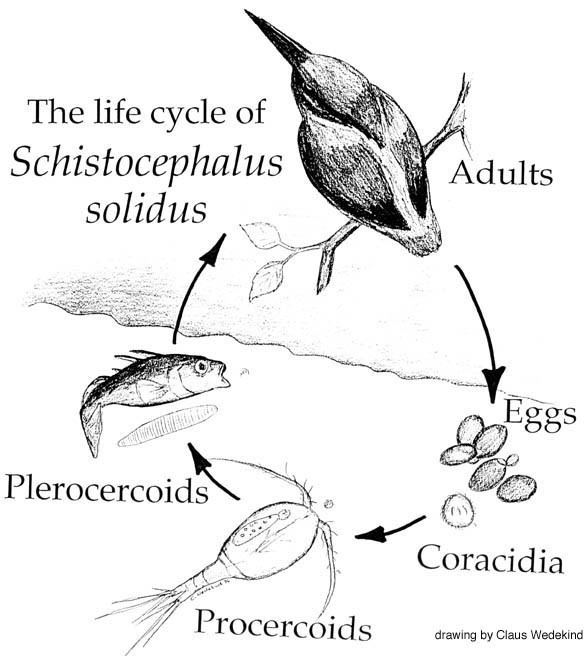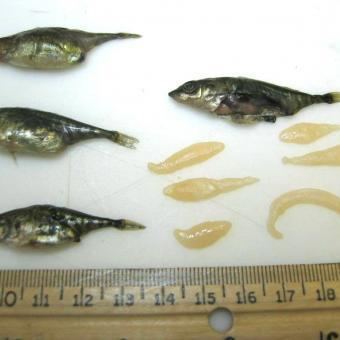Subfamily Schistocephalinae Higher classification Schistocephalus Order Pseudophyllidea | Family Schistocephalidae Genus Schistocephalus Phylum Platyhelminthes Rank Species | |
 | ||
Similar Tapeworms, Gasterosteus, Three‑spined stickleback, Pseudophyllidea, Macrocyclops albidus | ||
Schistocephalus solidus life cycle
Schistocephalus solidus is a tapeworm of fish, fish-eating birds and rodents.
Contents
This hermaphroditic parasite belongs to the Eucestoda subclass, of class Cestoda. It parasitizes fish and fish-eating water birds. The fish-eating water bird is the definitive host and reproduction occurs in the bird's intestine. Eggs of the tapeworm are passed with the bird’s feces and hatch in the water where the first larval stage, the coracidium, is produced. The coracidium is then ingested by the first intermediate host, a cyclopoid copepod (e.g. Macrocyclops albidus). The second larval stage then subsequently develops in the tissue of this host. Within one to two weeks, the infected copepod is ingested by the second intermediate host, the three-spined stickleback, Gasterosteus aculeatus. The third larval stage, the plerocercoid, grows in the abdomen of the fish. When the fish is eaten by a bird, the larvae mature and adults start to produce eggs within two days. Reproduction takes place within one to two weeks, after which the parasite dies.

Reproduction for this parasite is unique because of the hermaphroditic nature of this cestode. When it comes to mating, S. solidus has three options: (1) self-fertilization (2) breeding with a sibling (3) breeding with an unrelated individual. There are advantages and disadvantages to each of these three options. For example, self-fertilization is advantageous when no mating partners are around but it is disadvantageous because of inbreeding depression—the reduced fitness of offsprings because of the unmasking of deleterious recessive alleles due to the breeding of closely related individuals. Another disadvantage of self-fertilization is not having the ability to exchange genes with other cestodes which leads to increased genetic variation.

Similarly, breeding with a sibling, also known as incestuous mating, also shares some of the same disadvantages as self-fertilization does—inbreeding depression and lack of genetic variation. But incestuous mating is advantageous because it helps maintain gene complexes within the family which may be important for local adaptation purposes. Breeding with unrelated individuals might seem to be most advantageous choice of mating because it increases genetic variation and avoids inbreeding depression, but it could be a very time consuming process.

Data from Schjørring and Jäger's article shows that incestuous mating among S. Solidus significantly reduced the success of egg hatching. Hatching rate of eggs produced by pairs of cestodes that were not related was 3.5 times higher than those that were produced by the sibling pairs. However, those eggs hatched 2.3 times more successfully than eggs that were produced through selfing. The results observed in this experiment corroborates previous studies of S. Solidus showing that eggs produced through selfing correlates with a reduction in hatching success. Although these earlier findings confirmed this study’s result, there was a slight disconnect in the rates of egg hatching. Both sources, Christen et al. and Schjørring, found that the hatching rate of egg from unrelated cestodes was 4 times higher than eggs from selfing, while this experiment found that the rate was 8 times higher. This discrepancy can be attributed to study source and the environment in which the experiment was conducted. The previous studies used wild cestodes while this study observed offsprings of wild cestodes bred in the laboratory. It has been speculated that a laboratory environment lowers selective pressures that would otherwise be present in the wild, thus allowing for genes that would be suppressed in the wild to be passed on to the next generation.

Considering the evolutionary disadvantages that may arise from incestuous mating, scientists would suspect cestodes to sexually prefer unrelated mates. Galvani speculates that because S. Solidus are parasites, that the cestodes would be under extreme selective pressures to uphold an evolutionary advantage over the host thus would avoid the genetically unfavorable consequences that would result from incestuous mating.

However, this study contradicts Galvani’s prediction showing that even when presented with alternatives, the cestodes were observed to spend a considerable amount of time around the related cestode as can be seen in the plot of Mean Position by Eggs per Mg Cestodes. The data supports the hypothesis that S. Solidus have a preference for siblings and there exists a positive relationship between number of eggs produced and the amount of time spent in close proximity to the related cestode. This study found that pairs that exhibited strong sibling preference produced 12% more eggs in comparison to eggs produced by unrelated pairs.
Kokko and Ots suggests that, despite inbreeding depression, there exists a significant advantage to incestuous mating choices. Their paper states that there are indirect and direct fitness benefits that outweigh the cost of inbreeding. In species where there is low parental investment and sexual encounters are rare and sequential, incestuous breeding is indirectly beneficial. If the prospective mates are related there is an increase mutual interest in finding a resolution with respect to playing the unpreferred sexual role. With less time allotted to conflicting over sexual roles and dominating one another, procreation is more cost-effective. Under these conditions, the greater effectiveness of inbreeding prevails over the detriment of incestuous mating and evolutionarily select for a preference for related mates.
